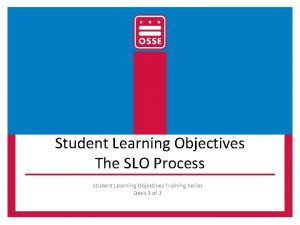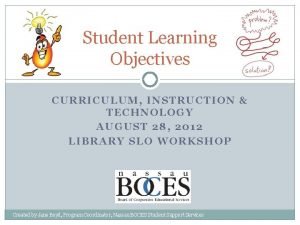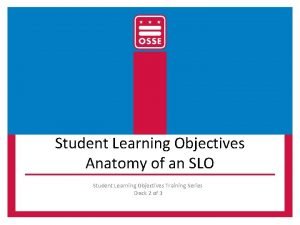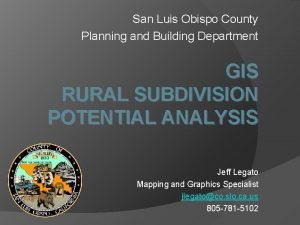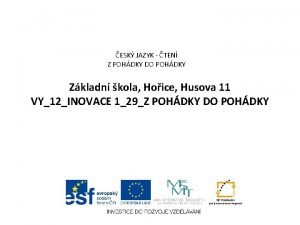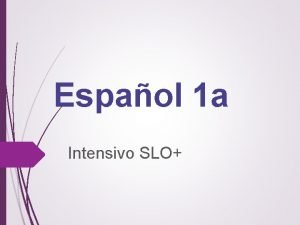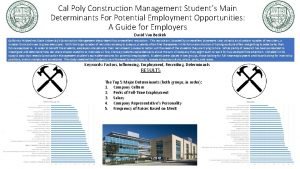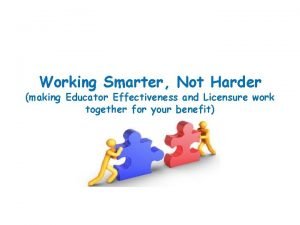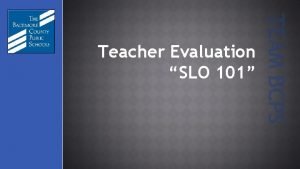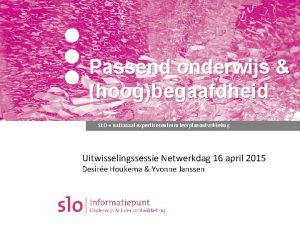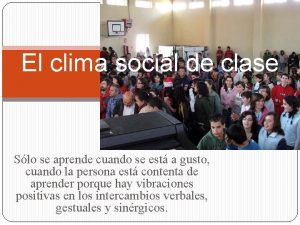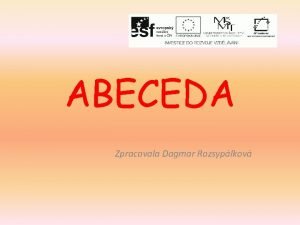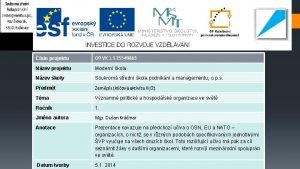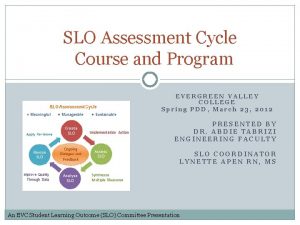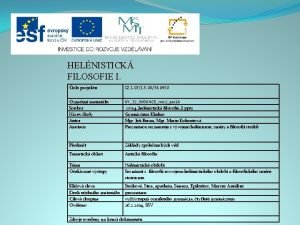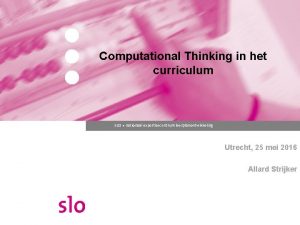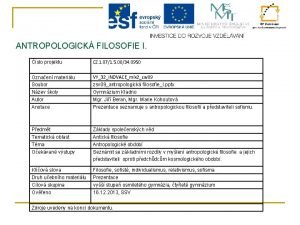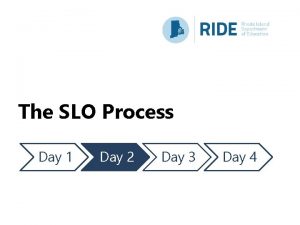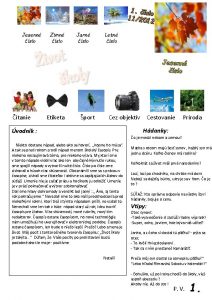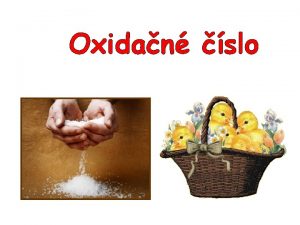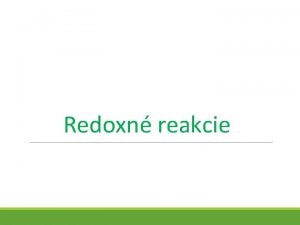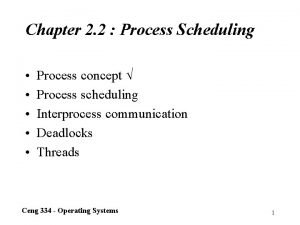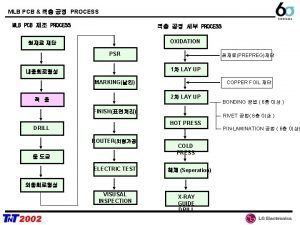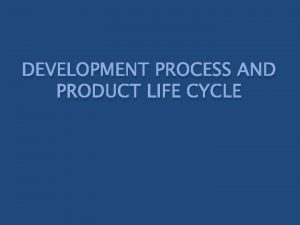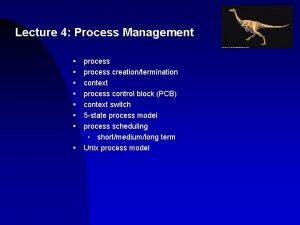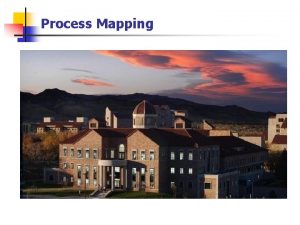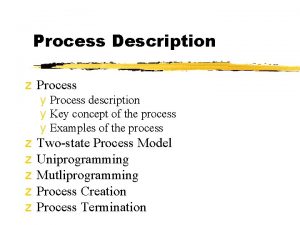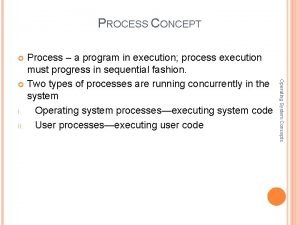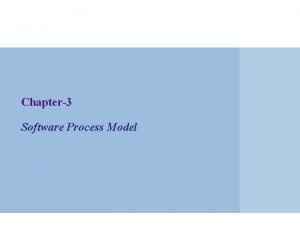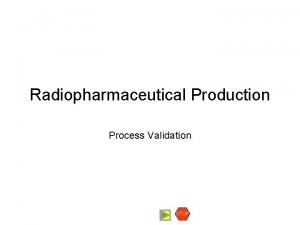The SLO Process Day 1 Day 2 Day








































































- Slides: 72

The SLO Process Day 1 Day 2 Day 3 Day 4

Academy Agenda Day One -Framing the Work and Introduction to the Professional Practice Rubric -Introduction to the Online Observer Training (FFTPS) -Component 2 A Training -Professional Practice Evidence Collection Day Two -Part I: Building an Understanding of the Day Three Parts -Practice observation -Part II: The Evaluator’s Process calibration protocol -Calculating a Final -Part III: Effectiveness Rating Implementation: Overcoming Challenges and Utilizing Resources Day Four -Understanding the Support Professional Model -RIDE’s Data Systems

Objectives and Agenda Objectives: • Develop an understanding of high-quality SLOs • Understand the role of evaluators throughout the SLO process • Consider best-practices for implementation, including overcoming challenges and utilizing resources Agenda: Part I: Building an Understanding of the Parts § Intro and Framing § Understanding SLOs § Writing Objective Statements § Baseline Data & Information § Deepening Assessment Literacy with the Assessment Toolkit § Setting Targets for Student Learning --LUNCH— Part II: The Evaluator’s Process § Approving SLOs § Mid-Year Revisions § Scoring SLOs Part III: Implementation – Overcoming Challenges and Utilizing Resources § Getting from Intent to Implementation § RIDE resources § Proactive planning 3

Norms Equity of voice Safety to share different perspectives Active listening Norms Respectful/ appropriate use of technology Confidentiality Usage of parking lot 4

Dual-Track Learning PARTICIPANT PACKET: ü Utilize the note taking template ü Jot down key messages that you feel would be important to communicate to your teachers BIG IDEAS NEXT STEPS AS A LEARNER DETAILS/QUESTIONS NEXT STEPS AS AN INSTRUCTIONAL LEADER 5

SLOs in Rhode Island Student Learning Objectives (SLOs) are long-term, measurable academic goals that educators set for their students. They should focus on priority content, be measured by appropriate sources of evidence, and include specific targets for student mastery or progress. They are used as a measure of student learning by all educators participating in the Educator Evaluation System. • Respects the diversity of all grades, subjects, and courses • Written by educators for their own students • Tied directly to the teaching and learning happening in every teacher’s individual classroom • Reflects the most important content and skills students should learn Improving student learning is at the center of all our work. Teachers have the greatest school-based impact on student learning. Research shows that student learning improves when teachers set goals. SLOs recognize and encourage the work that excellent teachers are already doing in their classrooms. 6

Making the Leap Video: Implementing SLOs in Rhode Island As you watch: What are the: a) Big Ideas and Messages; and b) Strategies or Lessons Learned that the educators in the video touch upon? 7

Understanding SLOs Objectives: • Understand how to use online tools • Understand how SLOs are an integral part of curriculum, instruction, and assessment Part I: Building an Understanding of the Parts § § § Intro and Framing Understanding SLOs Writing Objective Statements Baseline Data & Information Deepening Assessment Literacy with the Assessment Toolkit Setting Targets for Student Learning 8

Accessing RIDE’s Resources for Educator Evaluation 9

Online Modules & Tools 10

Layout and Functionality of Online Modules 11

Turn and Talk Is this how SLOs have been implemented in your district? If yes, what has made that possible? If no, what has prevented that from happening? 12

Layout and Functionality of Online Modules 13

Layout and Functionality of Online Modules 14

Understanding SLOs Takeaways § SLOs are focused on the student learning in specific content areas and grade levels § SLOs are integrated with the most important work of districts--curriculum, instruction, and assessment-and are not an add-on § Goal-setting is an important part of effective teachers' practice 15

Writing an Objective Statement Objective: • Clarify the process for writing an Objective Statement Part I: Building an Understanding of the Parts § § § Intro and Framing Understanding SLOs Writing Objective Statements Baseline Data & Information Deepening Assessment Literacy with the Assessment Toolkit Setting Targets for Student Learning 16

The Process for Writing a Student Learning Objective New Resource 17

Writing an Objective Statement 18

Examining Objective Statements 1. Objective Statement: (Elementary) Students will improve their overall proficiency in mathematics. a. Is the objective statement clear in articulating the content or skills students should achieve? � � b. Is the scope of the objective statement broad enough � to capture the most important course content or skills? � (If the focus is too narrow it might be possible to teach it in a � unit, but it will not be a central focus for students throughout the interval of instruction. If the focus is too broad it is not a targeted objective that is measurable. If the target is met, students should have the essential knowledge and/or skills necessary for success in the next grade, level of instruction, or will have narrowed a critical gap. ) Clear Not clear enough Too broad Acceptable Too Narrow 19

Examining Objective Statements 2. Objective Statement: (Middle School) All Gr. 6 -8 students who scored Substantially Below Proficient on the beginning-of-year mathematics pretest (86 students) will reach Nearly Proficient or above by the end-of-year post-test. a. Is the objective statement clear in articulating the content or skills students should achieve? � � b. Is the scope of the objective statement broad enough � to capture the most important course content or skills? � (If the focus is too narrow it might be possible to teach it in a � unit, but it will not be a central focus for students throughout the interval of instruction. If the focus is too broad it is not a targeted objective that is measurable. If the target is met, students should have the essential knowledge and/or skills necessary for success in the next grade, level of instruction, or will have narrowed a critical gap. ) Clear Not clear enough Too broad Acceptable Too Narrow 20

Examining Objective Statements 3. Objective Statement: (High School) Students will develop an understanding of the major events and eras of American history (as defined by the curriculum units). Through close reading and expository writing, students will analyze how cycles of conflict and cooperation affected different groups of people and shaped our modern society. a. Is the objective statement clear in articulating the content or skills students should achieve? � � b. Is the scope of the objective statement broad enough � to capture the most important course content or skills? � (If the focus is too narrow it might be possible to teach it in a � unit, but it will not be a central focus for students throughout the interval of instruction. If the focus is too broad it is not a targeted objective that is measurable. If the target is met, students should have the essential knowledge and/or skills necessary for success in the next grade, level of instruction, or will have narrowed a critical gap. ) Clear Not clear enough Too broad Acceptable Too Narrow 21

Examining Objective Statements 4. Objective Statement: (Elementary) Students will increase their fluency. a. Is the objective statement clear in articulating the content or skills students should achieve? � � b. Is the scope of the objective statement broad enough � to capture the most important course content or skills? � (If the focus is too narrow it might be possible to teach it in a � unit, but it will not be a central focus for students throughout the interval of instruction. If the focus is too broad it is not a targeted objective that is measurable. If the target is met, students should have the essential knowledge and/or skills necessary for success in the next grade, level of instruction, or will have narrowed a critical gap. ) Clear Not clear enough Too broad Acceptable Too Narrow 22

Examining Objective Statements 5. Objective Statement: (Middle School) Students will be able to write arguments to support claims with clear reasons, drawing relevant evidence from literary or informational texts to support analysis and reflection, and including the acknowledgement of opposing claims, references to credible sources, a concluding statement, and a formal style. a. Is the objective statement clear in articulating the content or skills students should achieve? � � Clear Not clear enough b. Is the scope of the objective statement broad enough to capture the most important course content or skills? (If the focus is too narrow it might be possible to teach it in a unit, but it will not be a central focus for students throughout the interval of instruction. If the focus is too broad it is not a targeted objective that is measurable. If the target is met, students should have the essential knowledge and/or skills necessary for success in the next grade, level of instruction, or will have narrowed a critical gap. ) � � � Too broad Acceptable Too Narrow 23

Examining Objective Statements 6. Objective Statement: (High School) Algebra I students will demonstrate proficiency with creating equations that describe numbers or relationships and solving equations with inequalities in one variable. a. Is the objective statement clear in articulating the content or skills students should achieve? � � b. Is the scope of the objective statement broad enough � to capture the most important course content or skills? � (If the focus is too narrow it might be possible to teach it in a � unit, but it will not be a central focus for students throughout the interval of instruction. If the focus is too broad it is not a targeted objective that is measurable. If the target is met, students should have the essential knowledge and/or skills necessary for success in the next grade, level of instruction, or will have narrowed a critical gap. ) Clear Not clear enough Too broad Acceptable Too Narrow 24

Writing Objective Statement Takeaways § When educators create their SLO Objective Statements, they should follow these four steps: 1) Examine their standards and curriculum 2) Determine their Priority of Content 3) Write an objective statement 4) Check the scope, or grain-size 25

Using Baseline Data and Information to Set SLO Targets Objectives: • Understand the purpose of baseline data • Be able to identify several sources of baseline data • Understand how baseline data can be used to set targets Part I: Building an Understanding of the Parts § § § Intro and Framing Understanding SLOs Writing Objective Statements Baseline Data & Information Deepening Assessment Literacy with the Assessment Toolkit Setting Targets for Student Learning 26

Using Baseline Data and Information to Set SLO Targets 27

Baseline Data & Information Scenarios Review scenario 3 min Discuss scenario Whole group solution share 7 min 28

Scenario #1 When you sit down with Mr. Jacobs, a Biology teacher, to talk about his SLOs, he says that he does not have any baseline data. As he puts it, this is the first Biology course his 9 th graders have taken and the students matriculate from three different middle schools. There is no standardized 8 th grade Science curriculum in your district, so his students may have learned different things last year. What guidance would you give him? What could he use as sources of baseline data/information? 29

Scenario #2 Ms. Palmer and Mrs. Gray are your two 4 th grade teachers. They come to you because they are overwhelmed by the amount of information they have on their incoming students. In addition to students’ official records and state assessment scores, the 3 rd grade teachers have passed on writing and Social Studies portfolios, EOY reading levels, and detailed comments on each child’s behavior, interests, strengths, and areas for improvement. They don’t know where to begin. What guidance would you give them? How can this information be useful to them as their write their SLOs? 30

Scenario #3 Mrs. Scotto teaches French I to sixth graders at your middle school. She does not understand why she has to include baseline data in her SLO because none of her students speak any French at the beginning of the interval of instruction. How would you describe the purpose of baseline data/information to Mrs. Scotto and what recommendations might you give for possible sources that would be of use to her? 31

Scenario #4 Mr. Du. Bois is an 11 th grade English teacher. Prior to setting targets for his SLO, he reviewed his students’ grades and writing samples from their 10 th grade English courses. Based on those, he was able to make some preliminary groupings. However, after administering his first assignment of the year, he noticed that several students are performing differently than he expected (some much lower, some much higher). Now he is confused about how to group students and set appropriately tiered targets. What guidance would you give him? How should he handle these sometimes-conflicting data sources? 32

Conversation before Break Table Talk: How might you support teachers in collaborating in grade level or content-alike teams to engage in the 4 Step Process of setting Objective Statements? What additional support might new teachers need to engage in the process of collecting and analyzing Baseline Data and Information? How you might differentiate this for new and returning teachers? 33

Deepening Assessment Literacy with the Assessment Toolkit Objectives: • Develop a shared understanding of the various types and purposes of educational assessment • Identify best practices for local assessment development Part I: Building an Understanding of the Parts § § § Intro and Framing Understanding SLOs Writing Objective Statements Baseline Data & Information Deepening Assessment Literacy with the Assessment Toolkit Setting Targets for Student Learning 34

Deepening Assessment Literacy 35

The Assessment Toolkit 36

Assessment Quiz 1. Assessment development should always begin with identifying the: a. format b. purpose c. scale d. vendor 2. Summative assessments are primarily used to: a. Inform instruction b. Screen/identify c. Measure outcomes 3. Formative assessments should be used: a. To monitor progress toward SLO targets b. As evidence on SLOs 37

Assessment Quiz 4. In educational assessment, the construct is: a. The intended audience of the assessment b. What the assessment is supposed to measure c. The format of the assessment d. How the assessment is constructed 5. If you weigh 160 pounds, and every time you step on the scale it reports your weight as 190 pounds, that scale is: a. Valid, but not reliable b. Reliable, but not valid c. Neither valid nor reliable 6. NECAP score reports are an example of: a. Quantitative data b. Qualitative data 38

Assessment Quiz 7. Which of the following item types is most likely to produce false positives? a. Multiple choice b. Fill-in-the-blank c. Constructed response 8. Adding more items and norming scorers are two strategies for: a. Increasing rigor b. Decreasing cheating c. Increasing reliability 9. Written comments about student’s photography portfolios are an example of: a. Quantitative data b. Qualitative data 39

Assessment Quiz 10. Which of the following could be used as baseline data: a. Final grades in a pre-requisite course b. Pre-test scores c. Assignments from the first few weeks of school d. All of the above 11. Which of the following is an example of a modification: a. Providing a scribe to a student with a broken wrist b. Simplifying the numbers in a word problem for a student with a specific learning disability c. Enlarging print for a student with a visual impairment 12. Teacher-created performance tasks can be used as evidence for SLOs: a. True b. False 40

Assessment Quiz 13. What is validity? a. The degree to which the assessment measures what it is supposed to measure b. The consistency of assessment results across multiple administrations c. The degree to which the assessment is free from bias 14. Which of the following are true of pre-test/post-test models: a. It is difficult to equate forms b. Pre-test scores may be deflated c. Post-test scores may be inflated d. All of the above 41

Assessment Takeaways § Assessment is integral to teaching because it tells us what students know and are learning § Assessment selection/design should always begin with your purpose § SLOs are measured with summative assessments, though other types should be used for progress monitoring § Alignment, format, item type, administration, and scoring all contribute to the validity of assessment data 42

Setting Targets for Student Learning Objectives: • Develop a conceptual understanding of target-setting as part of the SLO process • Clarify frequently asked questions around target-setting • Develop a shared understanding of “rigorous yet appropriate” targets Part I: Building an Understanding of the Parts § § § Intro and Framing Understanding SLOs Writing Objective Statements Baseline Data & Information Setting Targets for Student Learning Deepening Assessment Literacy with the Assessment Toolkit 43

Setting Targets for Student Learning 44

Discussing the Online Module 1. Compare the notes you took while watching the online module with your table. Did you take away similar Big Ideas, Details/Questions, or Next Steps? 2. How will you share the guidance and resources with teachers? 45

Supporting Teachers as they Write SLOs: A Focus on Target Setting Directions: 1. Read the SLO. 2. For all completed answers code: I would have answered the question the same way I would have answered this question differently 3. Answer the five questions related to targets on your own. 4. Using stickers, indicate your answers to the five target questions on the posters around the room. 5. Be prepared for discussion. 46

The Evolution of an SLO 6 th grade sample: Writing Arguments in Response to Text DRAFT 1 EVALUATOR’S FEEDBACK 2 The initial draft submitted by a teacher The comments and suggested revisions from the evaluator or group of teachers REVISION 3 The revised sections from the teacher to reflect the evaluator’s comments HIGHLIGHTED CHANGES 4 Annotations that highlight these changes 47

Target Setting Takeaways What are some of your Target Setting takeaways? LUNCH! 48

Part II: The Evaluator’s Process Objectives: • Calibrate SLO approval using the Quality Review Tool • Determine if an SLO needs or does not need revision mid-year Part II: The Evaluator’s Process § § § Approving SLOs Mid-Year Revisions Scoring SLOs • Reflect on ways to support teachers in regard to student learning • Understand how to utilize two critical tools for scoring SLOs including the Scoring Process Map and Additional Scoring Guidance 49

The SLO Process 50

Approving SLOs 51

SLO Approval Calibration Independently Review SLO 5 min Complete SLO Quality Review Tool 10 min Whole group calibration 30 min 52

Mid-Year Revisions Most teachers will be making progress with their SLOs and the Mid-Year Conference will be an opportunity to formally check-in. Some teachers may voice concerns if students are not “on track” to meet their targets. This should trigger a more in-depth conversation, in which the evaluator decides whether or not the SLO needs revision. 1 SLO DOES NOT NEED REVISION 2 SLO NEEDS REVISION In either case, the evaluator provides feedback, guidance, and support, as necessary. NOTE: Just not being “on track” to meeting an SLO is not adequate as the only criteria for revision 53

Reasons for a Mid-year Revision SLO needs REVISION Teaching schedule The composition of or assignment the class have changed significantly New, more reliable sources of evidence are available New information gathered since they were set, objectives fail to address the most important learning challenges in the classroom/school 1. Revisions should be rare 2. There may be extenuating circumstances that do not fit these four categories in which the evaluator must use professional judgment p. 26 NOTE: Just not being “on track” to meeting an SLO is not adequate as the only criteria for revision 54

Process for SLOs that Require Action 1. Discuss SLO progress and any areas of concern 2. Evaluator will determine if the SLO should be maintained or revised and offer feedback SLO DOES NOT NEED REVISION 1. Evaluator and educator discuss reasons for not revising and how the original SLO can be met 2. Evaluator and teacher discuss options for supports throughout the remainder of the year, if necessary, and determine next steps SLO needs REVISION 1. Evaluator and educator discuss reasons for revising the SLO 2. Evaluator provides feedback on how to revise SLO 3. Evaluator unlocks SLO in EPSS; teacher revises and resubmits 4. Evaluator approves or sends back with feedback for additional revision 5. Evaluator and teacher discuss options for supports throughout the remainder of the year, if necessary, and determine next steps 55

The Connection to Professional Practice At the mid-year, if students are not making appropriate progress, it is important for teachers and evaluators to investigate WHY this is occurring with a sense of urgency to help students get back on track for success. One place to look is Professional Practice of a teacher. Are there areas that need focused support in order to impact student learning? Student Learning Objectives articulate Professional Practice components highlight students will learn educators effectively teach students WHAT HOW 56

Providing Feedback to Teachers If an SLO DOES NOT NEED REVISION: 1. Explain your reasoning for not allowing a revision to the SLO. 2. Provide options for supports, as necessary. If an SLO needs REVISION: 1. 2. Explain your reasoning for approving a revision. 3. Provide options for supports, as necessary. Provide feedback on how to revise SLO (be specific as to which elements require revision). 57

MY Revision: Scenario #1 Mr. Dewey wrote an SLO with a tiered target for his 3 rd, 4 th, and 5 th grade Visual Art classes, based on his original schedule, which allowed him to meet with the groups twice per week for 60 minutes. However, in late October, the 1 st and 2 nd grade Visual Art teacher unexpectedly quit. The schedule was reorganized so that the younger students could continue taking art. Now Mr. Dewey meets with the 1 st-5 th graders once per week for 60 minutes. Mr. Dewey has earned all 3 s and 4 s in observations so far, but when asked about his SLO, he reports that the older students are substantially behind his original mid-year benchmarks because of the schedule change and would like to revise his targets. 1 2 SLO DOES NOT NEED REVISION SLO needs REVISION 58

MY Revision: Scenario #2 Mrs. Callihan teaches in a school with a high population of transient students. In the beginning of the year, when she wrote her SLO, she had 22 students in her class. By the mid-year conference 5 students have left the school and 3 have joined her class. Since nearly 23% of her original students are no longer on her roster and the three additional students are not accounted for in her SLO, she has requested to revise it to include them. 1 2 SLO DOES NOT NEED REVISION SLO needs REVISION 59

MY Revision: Scenario #3 Ms. Ober has been teaching 6 th grade mathematics for eight years. At the beginning of the year, when first drafting her SLOs, she reviewed the end-ofyear performance of last year’s 6 th grade class. But when she began teaching this year, she found that many of her students did not have the foundational mathematical skills that her students had in the past. After examining student’s performance on September tasks she tried to set SLO targets accordingly. However, by November it became apparent to her that students’ gaps were wider than she initially thought and she needed to do quite a bit more remediation in order to get students prepared to access the 6 th grade material. She reports that 75% of students are on track to meet their goals and would like to adjust her targets to account for her students’ lack of foundational knowledge and the re-teaching she has had to do. 1 2 SLO DOES NOT NEED REVISION SLO needs REVISION 60

MY Revision: Scenario #4 Mr. Palazola set his SLOs in October but needed knee surgery and had to take medical leave for the months of November and December. Before he left he created clear lesson plans, with materials and assessments for the permanent substitute teacher and met with him to discuss the students and the upcoming units. When he returned in January he was disappointed to find his students far behind where they should have been. After talking with students and viewing their collected work it is clear to him that the substitute did not adhere to the plans and pacing. He feels he will not be able to meet the targets he initially set now and has requested to adjust them. 1 2 SLO DOES NOT NEED REVISION SLO needs REVISION 61

MY Revision: Scenario #5 Mr. Washington has created an SLO for his three sections of 8 th grade ELA. He thought out the targets carefully but when you meet with him at the mid-year conference he is discouraged by the fact that only 69% of students are on track to meet the targets based on the midterm. When asked to explain, he shows his class attendance records, which indicate that 16 of his 66 students (24%) miss school approximately once per week, and 4 students (6%) miss class approximately twice per week. All but three of the students who failed the midterm fall into one of these groups of frequently absent students. He expresses his belief that he would be able to get most students to meet the learning objective if he had more time with them. 1 2 SLO DOES NOT NEED REVISION SLO needs REVISION 62

MY Revision: Scenario #6 Ms. Williams taught 9 th grade honors classes for 7 years and has just started teaching 7 th grade this year for the first time. She created her SLO about writing arguments after analyzing literary and informational text at the beginning of the school year and set targets after administering baseline assessment tasks. However, as the year continued she realized that students had significant reading comprehension gaps. She has focused on developing their comprehension and believes the SLO should be rewritten to reflect this as the Objective Statement. 1 2 SLO DOES NOT NEED REVISION SLO needs REVISION 63

Scoring SLO Resources 1 2 64

The SLO Scoring Process Map 65

Additional SLO Scoring Guidance 66

The Importance of Approving High-Quality SLOs A critical part of making the SLO process a meaningful one is to ensure that SLOs (along with their associated assessments) are of high -quality in the fall. 67

Part III: Implementation Objectives: • Consider best-practices for implementation • Reflect on the day’s learning Part III: Implementation – Overcoming Challenges and Utilizing Resources § § § Getting from Intent to Implementation RIDE resources Proactive planning 68

The Challenge of Getting From Intent to Reality The Intent of the SLO Process • Reflects the most important content and skills students should learn • Respects the diversity of all grades, subjects, and courses • Written by educators for their own students • Tied directly to the teaching and learning happening in every teacher’s individual classroom The Reality of Implementation • Requires time for educators to collaborate in the writing of SLOs and the monitoring of student learning • Teachers and administrators need to have a strong foundation in standards & curriculum, assessment, and data use • The SLO process often shines a light on areas that districts or schools needed to attend to (with or without SLOs) • Local policies or practices can either turn SLOs into disconnected compliance or make them an integral part of reflective instruction 69

Resources to Support a Quality SLO Process What resources and tools can help educators and evaluators through the SLO process? §Guidebook §SLO FAQs §Indicators of a Strong SLO §SLO and SOO samples §The Process for Writing a Student Learning Objective: A Guide for Educators in Rhode Island §SLO Quality Review Tool §SLO Video §SLO Online Modules: Understanding SLOs Writing an Objective Statement Using Baseline Data and Information to Set SLO Targets Setting Targets for Student Learning Deepening Assessment Literacy The Assessment Toolkit Approving SLOs Scoring SLOs Special Educators and SLOs/SOOs Building Administrator SLOs §Assessment Tool #1: Quality Assessment Guidance §Assessment Tool #2: Using Baseline Data & Information Guidance and Worksheet §Assessment Tool #3: Assessment Review Tool §Assessment Tool #4: Protocols for Analyzing and Scoring Student Work §Setting Targets in Student Learning Objectives Guidance Document §Standard Setting for Local Assessments Guidance Document §Evolving SLO samples §SLO Approval Calibration Workshop materials §Scoring SLOs Calibration Workshop materials §SLO Self-Audit for LEAs and Schools 70

Discussion 1. Everyone identify one idea/message or strategy/lesson learned (from the educators in the video, from the online modules, from activities, from other participants or facilitators) that you think will be essential for you to use as an evaluator implementing SLOs this year. Discuss these in small groups. 2. Each table shares out with the larger group. 71

Reflecting on the Day 1. What were some of your personal takeaways from today? 2. What key messages did you prioritize for your teachers? 3. What resources do you plan to share with your teachers? 72
 Slo process
Slo process Day 1 day 2 day 3 day 4
Day 1 day 2 day 3 day 4 Slo goal statement examples
Slo goal statement examples Slo goal statement examples
Slo goal statement examples Slo goal statement examples
Slo goal statement examples Class objective
Class objective San luis obispo building department
San luis obispo building department Nationaal expertisecentrum leerplanontwikkeling
Nationaal expertisecentrum leerplanontwikkeling Jak šlo šídlo do lesa
Jak šlo šídlo do lesa Cal poly slo portal
Cal poly slo portal Slo by me
Slo by me Soy maestra
Soy maestra Construction management cal poly
Construction management cal poly Ppg examples for educator effectiveness
Ppg examples for educator effectiveness Bcps slo
Bcps slo Slo hoogbegaafdheid
Slo hoogbegaafdheid Clima slo
Clima slo Slo abeceda
Slo abeceda Slo student growth tracker
Slo student growth tracker Slo zkratka
Slo zkratka Evc slo
Evc slo I slo
I slo Slo computational thinking
Slo computational thinking Sap ecc/s4 carve out
Sap ecc/s4 carve out Slo hoy
Slo hoy I slo
I slo Day 1 day 2 day 817
Day 1 day 2 day 817 Hát kết hợp bộ gõ cơ thể
Hát kết hợp bộ gõ cơ thể Ng-html
Ng-html Bổ thể
Bổ thể Tỉ lệ cơ thể trẻ em
Tỉ lệ cơ thể trẻ em Gấu đi như thế nào
Gấu đi như thế nào Tư thế worms-breton
Tư thế worms-breton Chúa sống lại
Chúa sống lại Môn thể thao bắt đầu bằng từ đua
Môn thể thao bắt đầu bằng từ đua Thế nào là hệ số cao nhất
Thế nào là hệ số cao nhất Các châu lục và đại dương trên thế giới
Các châu lục và đại dương trên thế giới Công thức tính thế năng
Công thức tính thế năng Trời xanh đây là của chúng ta thể thơ
Trời xanh đây là của chúng ta thể thơ Cách giải mật thư tọa độ
Cách giải mật thư tọa độ Phép trừ bù
Phép trừ bù Phản ứng thế ankan
Phản ứng thế ankan Các châu lục và đại dương trên thế giới
Các châu lục và đại dương trên thế giới Thể thơ truyền thống
Thể thơ truyền thống Quá trình desamine hóa có thể tạo ra
Quá trình desamine hóa có thể tạo ra Một số thể thơ truyền thống
Một số thể thơ truyền thống Cái miệng nó xinh thế
Cái miệng nó xinh thế Vẽ hình chiếu vuông góc của vật thể sau
Vẽ hình chiếu vuông góc của vật thể sau Thế nào là sự mỏi cơ
Thế nào là sự mỏi cơ đặc điểm cơ thể của người tối cổ
đặc điểm cơ thể của người tối cổ Thế nào là giọng cùng tên
Thế nào là giọng cùng tên Vẽ hình chiếu đứng bằng cạnh của vật thể
Vẽ hình chiếu đứng bằng cạnh của vật thể Fecboak
Fecboak Thẻ vin
Thẻ vin đại từ thay thế
đại từ thay thế điện thế nghỉ
điện thế nghỉ Tư thế ngồi viết
Tư thế ngồi viết Diễn thế sinh thái là
Diễn thế sinh thái là Dạng đột biến một nhiễm là
Dạng đột biến một nhiễm là Số nguyên là gì
Số nguyên là gì Tư thế ngồi viết
Tư thế ngồi viết Lời thề hippocrates
Lời thề hippocrates Thiếu nhi thế giới liên hoan
Thiếu nhi thế giới liên hoan ưu thế lai là gì
ưu thế lai là gì Hổ đẻ mỗi lứa mấy con
Hổ đẻ mỗi lứa mấy con Khi nào hổ con có thể sống độc lập
Khi nào hổ con có thể sống độc lập Sơ đồ cơ thể người
Sơ đồ cơ thể người Từ ngữ thể hiện lòng nhân hậu
Từ ngữ thể hiện lòng nhân hậu Thế nào là mạng điện lắp đặt kiểu nổi
Thế nào là mạng điện lắp đặt kiểu nổi Schoolmax login
Schoolmax login Ocean the part day after day
Ocean the part day after day Day to day maintenance
Day to day maintenance Physical science chapter 6 review answers
Physical science chapter 6 review answers
